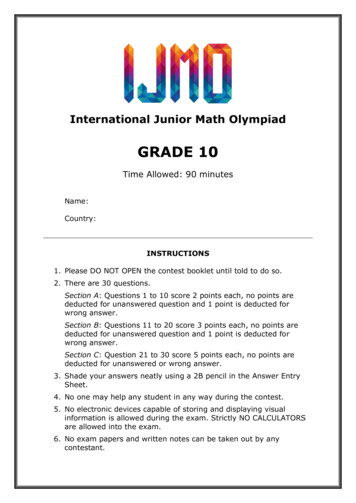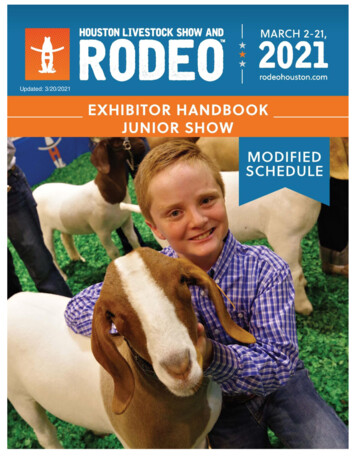
Transcription
International Junior Math OlympiadGRADE 10Time Allowed: 90 minutesName:Country:INSTRUCTIONS1. Please DO NOT OPEN the contest booklet until told to do so.2. There are 30 questions.Section A: Questions 1 to 10 score 2 points each, no points arededucted for unanswered question and 1 point is deducted forwrong answer.Section B: Questions 11 to 20 score 3 points each, no points arededucted for unanswered question and 1 point is deducted forwrong answer.Section C: Question 21 to 30 score 5 points each, no points arededucted for unanswered or wrong answer.3. Shade your answers neatly using a 2B pencil in the Answer EntrySheet.4. No one may help any student in any way during the contest.5. No electronic devices capable of storing and displaying visualinformation is allowed during the exam. Strictly NO CALCULATORSare allowed into the exam.6. No exam papers and written notes can be taken out by anycontestant.
GRADE 10International Junior Math Olympiad Past Year PaperSECTION A – 10 questionsQuestion 1ABC is an equilateral triangle. A circle with radius 1 is tangent to the lineAB at the point B and to the line AC at point C. What is the side length ofABC?A. 32 1B. 3C. 32D. 2 3E. 2Question 2You throw three regular six-sided dice. What is the probability that youwill get one odd number and two even numbers?A.1B.3C.48427D.1E.123Question 3If 𝑚 2(3)(4)(5) (31)(32), which statement about m is true?A. 𝑚 240B. 240 𝑚 270C. 270 𝑚 2100D. 2100 𝑚 2130E. 2130 𝑚Page 1
GRADE 10International Junior Math Olympiad Past Year PaperQuestion 4Real numbers a and b satisfy the equations 3𝑎 81𝑏 2 and 125𝑏 5𝑎 3 .What is ab?A. -60B. -17C. 9D. 12E. 60Question 5What are the last two digits of 20172017 ?A. 77B. 81C. 93D. 37E. 57Question 6Students from Mrs. Hein’s class are standing in a circle. They are evenlyspaced and consecutively numbered starting with 1. The student withnumber 3 is standing directly across from the student with number 17.How many students are there in Ms. Hein’s class?A. 28B. 29C. 30D. 31E. 32Page 2
GRADE 10International Junior Math Olympiad Past Year PaperQuestion 7A singles tournament had six players. Each player played every otherplayer only once, with no ties. If Helen won 4 games, Ines won 3 games,Janet won 2 games, Kendra won 2 games and Lara won 2 games, howmany games did Monica win?A. 0B. 1C. 2D. 3E. 4Question 8Points A, B, C, D, and E are on a line such that AB 3, BC 6, CD 8,and DE 4. What is the smallest possible value of AE?A. 0B. 1C. 2D. 3E. 5Question 9Which one of the following numbers is equal toA. 2016B. 4031C. 4033D. 2 (20172 20162 )E. 2016 2017Page 320174 2016420172 20162?
GRADE 10International Junior Math Olympiad Past Year PaperQuestion 10There are 20 students in a class. If one new boy joins the class, there willbe twice as many boys as girls in the class. What is the product of thenumber of boys and the number of girls in the class?A. 75B. 84C. 91D. 96E. 100Page 4
GRADE 10International Junior Math Olympiad Past Year PaperSection B – 10 questionsQuestion 11Per, Ragnar, and Lars live in the same neighbourhood. They have foundout that the straight line distance from Per's house to Ragnar's house is250 m, and from Ragnar's house to Lars' house is 300 m. Which of thefollowing is true about the distance between Per's house and Lars' house?A. The distance is precisely 550 m.B. The distance is between 0 m and 550 m.C. The distance is between 50 m and 550 m.D. The distance is between 250 m and 300 m.E. The distance can be any value.Question 12Let n be the largest integer such that n 2017 and the sum of its digitsequals the product of its digits. Find the sum of the digits of n.A. 2B. 3C. 4D. 6E. 8Page 5
GRADE 10International Junior Math Olympiad Past Year PaperQuestion 13The diagram shows an octagon consisting of 10 unit squares. The shapesbelow PQ is a unit square and a triangle with base 5. If PQ divides the𝑋𝑄area of the octagon into two equal parts, what is the value of 𝑄𝑌 ?A.2B.1C.3D.2E.352534Question 14If 𝑎1 𝑎2 1, 𝑎2 𝑎3 2, 𝑎3 𝑎4 3, 𝑎4 𝑎5 4, 𝑎50 𝑎51 50 and 𝑎51 𝑎1 51, what is the sum of 𝑎1 , 𝑎2 , 𝑎3 , , 𝑎51 ?A. 663B. 1326C. 1076D. 538E. 665Page 6
GRADE 10International Junior Math Olympiad Past Year PaperQuestion 15Which one of these numbers must be placed in the middle (3rd) if they areto be arranged in increasing or decreasing order?A. 𝜋B. 12C.7D. 11 132E.2211 11 13Question 16The numbers 𝑎1 , 𝑎2 , 𝑎3 and 𝑎4 are drawn one at a time from the set {0, 1,2, , 9}. If these four numbers are drawn with replacement, what is theprobability that 𝑎1 𝑎4 𝑎2 𝑎3 is an even number?A.1B.1C.3D.3E.524848Question 17What is 3𝑎𝑏 8𝑎 3𝑏 , if 𝑎𝑏 2?A. 5B. 7C. 8D. 24E. 70Page 7
GRADE 10International Junior Math Olympiad Past Year PaperQuestion 18Arne has a box with 100 chips of colours red, white, blue, and black. Eachchips has only one colour. Arne told Berit that she (Berit) must pick atleast 81 chips from the box to be sure of getting at least one of eachcolour, if she picks them without looking. After some thought, Beritconcluded correctly that the box contains at least N chips of each colour,but at most M of each. What is the smallest possible value of 𝑀 𝑁?A. 0B. 5C. 20D. 40E. 60Question 19Emmy is playing with a calculator. She enters an integer, and takes itssquare root. Then she repeats the process with the integer part (rounddown) of the answer. After the third process, the integer part equals 1 forthe first time. What is the difference between the largest and the smallestnumber Emmy could have started with?A. 229B. 231C. 239D. 241E. 254Question 20Peter has three boxes, with ten balls in each. He plays a game in whichthe goal is to end up with few balls as possible in the boxes. The boxesare each marked with one number from {4,7,10}. It is allowed to removeN balls from the box marked with the number N, put three of them aside,and put the rest in another box. What is the least total number of balls inthe boxes can contain in the end?A. 0B. 2C. 3D. 5E. 6Page 8
GRADE 10International Junior Math Olympiad Past Year PaperSection C – 10 questionsQuestion 21Let 𝑝(𝑥) 𝑥 4 𝑎𝑥 3 𝑏𝑥 2 𝑐𝑥 𝑑 where a, b, c, d be real numbers. It is𝑝(9) 𝑝( 5) 4known that 𝑝(1) 841, 𝑝(2) 1682 and 𝑝(3) 523. Find. 16Question 22Consider the sequence of real numbers (𝑎𝑛 ), for n 1, 2, 3, ,𝑎1 2 and 𝑎𝑛 (𝑛 1)(𝑎 𝑎𝑛 1 ) for all n 2.1𝑛 1𝑎2017Determine the value of22017.Question 23There are eight positive integers in a row. Starting from the third, each isthe sum of the two numbers before it. If the eighth number is 2017, whatis the largest possible value of the first one?Question 24The third, fourth, seventh and last terms of a non-constant (numbers aredifferent) arithmetic progression form a geometric progression. Find thenumber of terms of this progression.Question 25The function 𝑓(𝑥) has the following properties𝑥1i.𝑓 (𝑥 1) 2 𝑓(𝑥)ii.𝑓(1 𝑥) 1 𝑓(𝑥)11for all positive real numbers 𝑥. Find the value of 𝑆𝑛 𝑓(1) 𝑓 (2) 𝑓 (3) 1 𝑓(𝑛).Question 26Given that 5𝑟 4𝑠 3𝑡 6𝑢 100, where r s t u 0 are realnumbers, find the sum of the maximum and minimum possible values of𝑟 𝑠 𝑡 𝑢.Page 9
GRADE 10International Junior Math Olympiad Past Year PaperQuestion 27There are 10 children in a row. In the beginning, the total number ofmarbles girls have were equal to the total number of marbles boys have.Then each child gave a marble to every child standing to the right of him(or her). After that, the total number of marbles girls have increased by25. How many girls are there in the row?Question 28Anna and Birger walks at the same constant speed. They start at thesame place, facing in the same direction. Birger walked in that directionthroughout the time. Anna, however, turned 90 degrees to the rightimmediately after her first step. Then she turned another 90 degrees tothe right immediately after taking two more steps, and yet another 90degree turn to the right immediately after taking four more steps. Shewalked this way, doubling the number of steps every time she turns.When Anna was about to turn for the 9th time, both of them stopped Findthe integer part of the distance between them when they stopped.Question 29The sum of several distinct positive integers is equal to 30. Find themaximum value of their product.Question 30Let a, b, x, y be real number such that:𝑎 𝑏 23; 𝑎𝑥 𝑏𝑦 79; 𝑎𝑥 2 𝑏𝑦 2 217; 𝑎𝑥 3 𝑏𝑦 3 691What is the value of 𝑎𝑥 4 𝑏𝑦 4 ?END OF PAPERPage 10
GRADE 930International Junior Math Olympiad Past Year 005032367201993Page 11
International Junior Math Olympiad GRADE 10 Time Allowed: 90 minutes . Name: Country: INSTRUCTIONS . 1. Please DO NOT OPEN the contest booklet until told to do so. 2. There are 30 questions. Section A: Questions 1 to 10 score 2 points each, no points are deducted for unanswered question and 1 point is deducted for wrong answer. Section B











